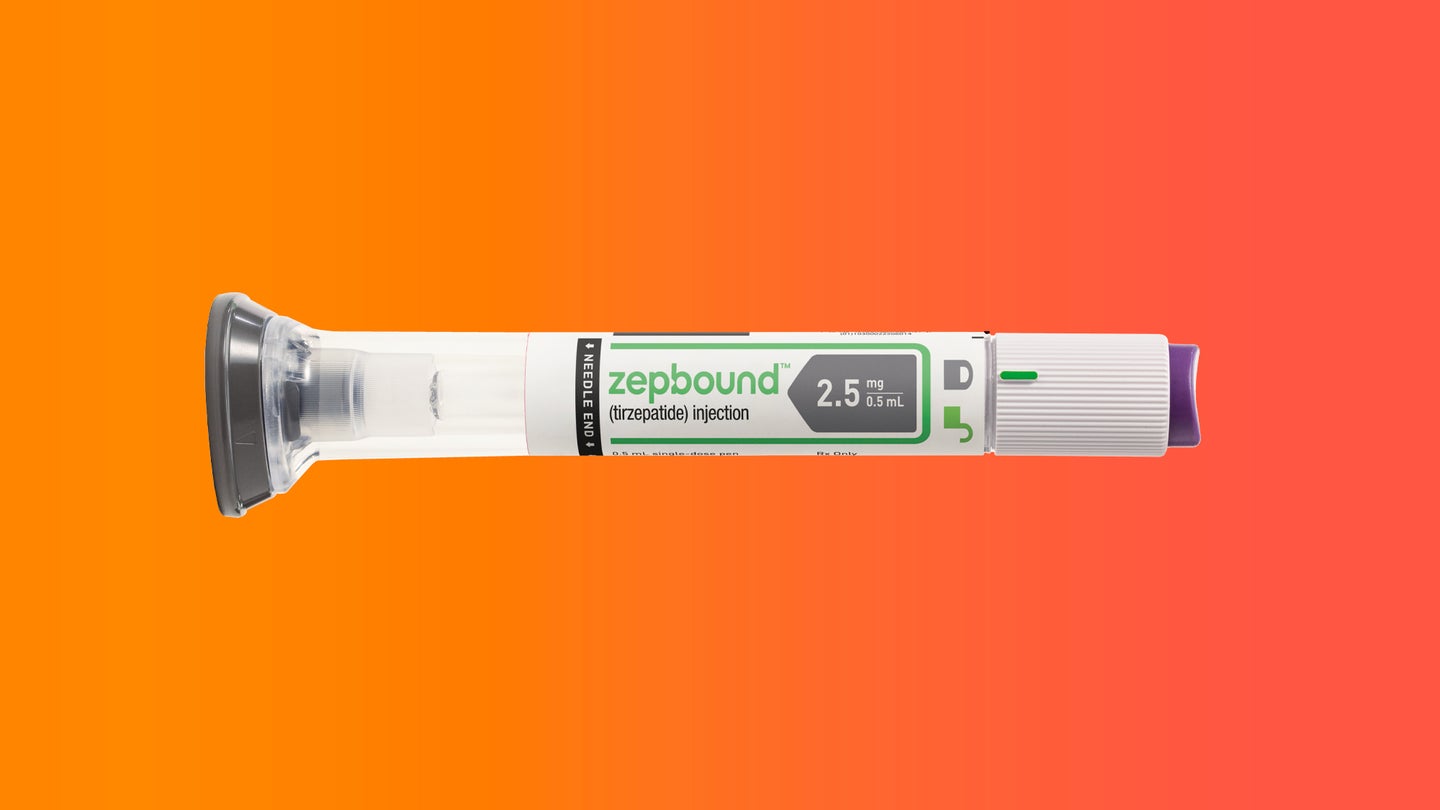What is Zepbound? Here’s how the newly FDA-approved weight loss drug works.
The weekly injectable medication is not exactly the same as Ozempic or Wegovy.

On November 8, the United States Food and Drug Administration (FDA) approved a Type 2 diabetes drug called tirzepatide for use in chronic weight management. It has been sold under the brand name Mounjaro for treating diabetes, but it will be called Zepbound when prescribed for weight loss. The drug is made by pharmaceutical company Eli Lilly and doses should be available after Thanksgiving.
[Related: 6 Ozempic facts that make sense of social media hype.]
How Zepbound works
The medicine is a weekly injectable medication and the main ingredient is called tirzepatide. It mimics two hormones called glucagon-like peptide-1 (GLP-1) and glucose-dependent insulinotropic polypeptide (GIP). Both are naturally produced in the body and the drug targets receptors in the brain for these hormones.
Both GIP and GLP-1 bind to receptors in the brain that tell the body it is full. GLP-1 also slows digestion to make people feel fuller longer and with smaller portions. American Board of Obesity Medicine medical director Kimberly Gudzune told The Washington Post that GLP-1 targets the receptors in the brain that decrease appetite and it slows digestion to make people feel fuller longer and with smaller portions. Additionally, GLP-1 increases the amount of insulin that the pancreas releases after eating, which slows down the rise in blood sugar.
GIP meanwhile works in the brain to decrease appetite and may also improve how the body breaks down fats and sugars.
Who is eligible for Zepbound?
The FDA cleared Zepbound for adults 18 and older considered obese (a body mass index of at least) or overweight (a body mass index of 27 or more) with at least one weight-related health condition. The FDA also said that it should be taken with exercise and a reduced-calorie diet.
What is a ‘weight-related condition’?
Weight-related conditions are medical complications that can arise from being overweight or obese. According to the Centers for Disease Control and Prevention (CDC), they include high blood pressure (hypertension), high LDL cholesterol, high levels of triglycerides, and Type 2 diabetes.
Roughly 70 percent of American adults are considered overweight or obese by body mass index, according to the FDA. However, body mass index (BMI) is an imperfect metric for measuring health that has been questioned by the American Medical Association. Losing five to 10 percent of body weight with diet and exercise has been associated with a reduced risk of cardiovascular disease in adults who are overweight or obese
“Obesity and overweight are serious conditions that can be associated with some of the leading causes of death such as heart disease, stroke and diabetes,” director of the FDA’s Division of Diabetes, Lipid Disorders, and Obesity John Sharretts, said in a statement. “In light of increasing rates of both obesity and overweight in the United States, today’s approval addresses an unmet medical need.”
[Related: TikTokers are taking a diabetes drug to lose weight. Now it’s in short supply.]
How effective is Zepbound?
The FDA’s approval comes on the heels of a phase 3 clinical trial. All of the participants in the study had obesity or were overweight and had at least one weight-related condition.
At the highest dosage of tirzepatide (15 milligrams) participants saw an average weight loss 22.5 percent body weight, or about 52 pounds, over a period of 72 weeks. At a 10 mg dose, the average weight loss was about 21.4 percent (48 pounds). At only five milligrams, average weight loss was about 16 percent (35 pounds).
How does it compare to Ozempic or Wegovy?
Ozempic and Wegovy contain an ingredient called semaglutide. It works by suppressing the appetite by mimicking GLP-1, a hormone that signals to the brain that the stomach is full. In similar clinical trials, semaglutide has been shown to reduce body weight by roughly 15 percent (34 pounds) after 68 weeks.
By comparison, the tirzepatide in Mounjaro and Zepbound works on both the GLP-1 and GIP pathways.
While those taking tirzepatide lost more weight than those taking semaglutide in separate trials, the data is not comparable due to potential differences in study length and population. More data is needed that compares both drugs at the higher doses needed for weight-loss, so it is too early to say if one is more effective than the other.
[Related: Fatphobia and medical biases follow people after death.]
What are the potential side-effects?
In studies, the main side effects were gastrointestinal issues like nausea, vomiting, constipation, and diarrhea. The FDA says that Zepbound’s label will contain warnings for inflammation of the pancreas, gallbladder problems, low blood sugar, acute kidney injury, diabetic retinopathy, and suicidal behavior or thinking.
How much will Zepbound cost?
A one month supply of Zepbound is estimated to cost about $1,060. While it is less than Wegovy’s $1,300 price tag, both drugs may be too expensive for many that are eligible. Ozempic costs $936 per month before insurance.
Many insurance companies do not cover weight loss medication that is intended to treat Type 2 diabetes, but that could change with the FDA’s approval. Medicare and Medicaid are currently barred by law from covering weight loss medications.
According to Eli Lilly, patients can sign up on its website for a copay, or a discount card program. The company also said that those who can get Zepbound through commercial insurance may pay as little as $25 for a one-month or three-month supply. It is unclear what will happen after that period as far as coast and weight staying off. Those who are commercially insured, but don’t have coverage for Zepbound, might be eligible to pay as little as $550 for a one-month prescription.
